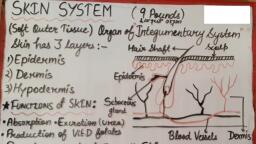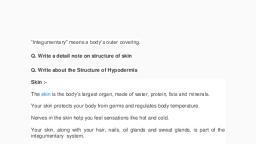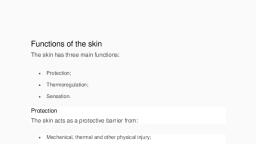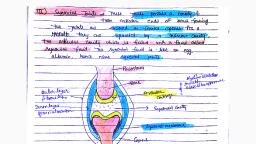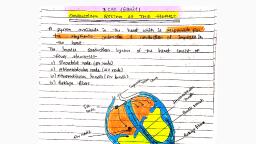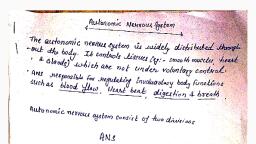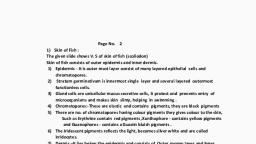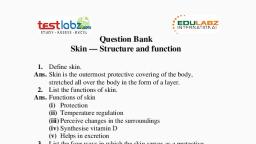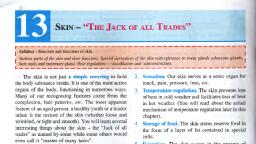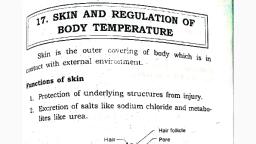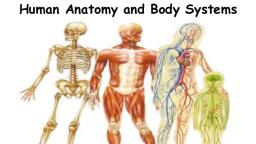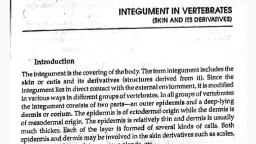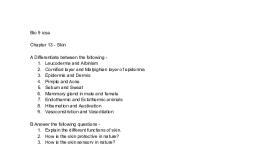Page 1 :
Skin (Integumentary System), considered an organ or an organ system, body’s largest organ, ‡organ of greatest surface area:15-20 sq ft. (1.5-2 m2 ), General Functions:, 1. protection, mechanical, chemical, bacterial, UV, desiccation, 2. temperature homeostasis, >temp ‡ sweat glands, flushing, <temp ‡ arrector pili, pale, 3. excretion, affects fluid & electrolyte balance, sweat glands release: water, salts, ammonia, oil glands release: lipids, acids, 4. sensation, touch (light touch, wind, etc), pressure, heat, cold, pain, 5. synthesis, vitamin D precursor passes through capillaries, in skin and light converts it to vitamin D, 6. nonverbal communication, eg. humans and other primates have much, more expressive faces than other animals, Layers of Skin:, epidermis, dermis, hypoderms, Human Anatomy & Physiology: Integumentary System, Lecture Notes, Ziser, 2005, , 1
Page 2 :
Epidermis, stratified squamous epithelium, upper layers dead, filled with keratin (waxy protein), lower layers living cells, replaced every 35-45 days, subdivided into 5 identifiable layers:, a. stratum basale, lowermost layer of epidermis, single cell layer thick, only cells that get adequate nutrition and oxygen by diffusion, from tissues below, actively dividing cells, bordered below by basement membrane, b. stratum spinosum, several layers thick, less mitosis, flattened, irregular, spinelike projections, [basale + spinosum = stratum germinativum, ‡ growing layers], c. stratum granulosum, very thin; 2-3 cell layers thick, as cells move up from s. basale they die & get flatter, and thinner, keratinization begins here, d. stratum lucidum, thin translucent band, only found in thick areas of epidermis:, soles of feet, palms of hand, e. stratum corneum, thickest of all layers; 3/4th ‘s the thickness of epidermis, 20-30 cell layers thick, dead cells completely filled with keratin, water resistant, main protection against biological and chemical assault, takes keratinocytes 30-40 days from their formation in, s basale until they flake off of the s corneum, cells of epidermis:, Human Anatomy & Physiology: Integumentary System, Lecture Notes, Ziser, 2005, , 2
Page 3 :
1. stem cells ‡ undifferentiated cells found only in deepest layer, 2. keratinocytes ‡ most cells in epidermis synthesize keratin, 3. melanocytes ‡ also in deepest layer synthesize pigment, melanin, 4. Merkel cells ‡ touch receptors, attached to nerve cell, 5. dentritic cells(Langerhans cells) ‡ found in s spinosum, and s granulosum, are macrophages that stand guard against toxins,, microbes and other pathogens that penetrate the, skin‡ if detected they alert immune system, , Dermis (=hide), strong, flexible, connective tissue, gives skin its strength and resilience, gel-like matrix, contains collagen, elastic and reticular fibers, rich in nerves, receptors, blood vessels, lymph vessels, hair follicles and sweat glands extend into it, two layers:, a. papillary layer, mainly areolar connective tissue, lots of blood vessels, dermal papillae, capillary loops, sensory cells, produce finger prints, b. reticular layer, mainly dense (irregular connective tissue), lots of collagen fibers, lines of cleavage between collagen bundles, ‡ tension lines, longitudinal in limbs, circular around trunk, incisions parallel to lines heal quicker, dermal tearing = stretch marks (silvery), Subcutaneous Layer, Human Anatomy & Physiology: Integumentary System, Lecture Notes, Ziser, 2005, , 3
Page 4 :
= hypodermis or superficial fascia, below skin, mainly adipose tissue (ie subcutaneous fat), insulation, infants and elderly have less of this than adults and are therefore more, sensitive to cold, Skin Color, due to combination of three different pigments:, melanin, yellow, orange, brown or black pigments, racial shades due mainly to kinds and amount of melanin pigments, mainly in stratum basale, also, amount varies with exposure to sun=suntan, carotene, esp in stratum corneum and subcutaneous layers, hemoglobin, in blood of skin capillaries, Skin Color & Texture in Diagnosis, cyanosis = bluish cast ‡poor oxygenation, erythema = redness ‡ emotional, hypertension, inflammation, pallor = paleness ‡ emotion, anemia, low blood pressure, jaundice = yellowing ‡ liver disorder, >bile pigments in blood, bronzing = Addison’s disease, adrenal cortex, bruising (hematoma)= escaped blood has clotted, hematomas ‡ deficiency in Vit C or hemophilia, leathery skin = overexposure, clumping of elastin fibers, depressed immune system, can alter DNA to cause skin cancer, photosensitivity = to antibiotics & antihistamines, “Skin Markings”, skin is marked by many lines, creases and ridges, friction ridges:, ‡ markings on fingertips characteristic of primates, allow us to manipulate objects more easily, flexion lines:, on flexor surfaces of digits, palms, wirsts, elbows etc, Human Anatomy & Physiology: Integumentary System, Lecture Notes, Ziser, 2005, , 4
Page 5 :
skin is tightly bound to deep fascia at these points, freckles:, flat melanized patches, vary with heredity or exposure to sun, moles:, elevated patch of melanized skin, of the with hair, mostly harmless, beauty marks, “Derivitives of skin”, during embryonic development 1000’s of small groups of epidermal cells from, stratum basale push down into dermis to form hair follicles and glands, 1. Hair, covers entire body except palms, soles, lips,, nipples, parts of external genitals, hormones account for the development of “hairy” regions:, eg. head, axillary and pubic areas, humans are born with as many follicles as they will ever have, hairs are among the fastest growing tissues in the body, formation similar to epidermis, heavily keratinized, consists of:, shaft: visible part, root:, follicle: sheath surrounding root, papillae: vascularized, growing part of hair, Arrector Pili muscles, attached to follicle, causes hair to stand on end (cold, fright), oil glands: ≥2/follicle, hair receptor: entwines each follicle, responds to hair movements, hair color depends on kinds (yellow, rust, brown,, and black) and the amount of melanin cortex of shaft contains, hair texture related to differences in cross-sectional shape, eg. straight hair is round, Human Anatomy & Physiology: Integumentary System, Lecture Notes, Ziser, 2005, , 5
Page 6 :
eg. wavy hair is oval, eg. tightly curly hair is relatively flat, 2. Nails, scale-like modification of the epidermis, fingernails and toenails are clear,hard derivatives of stratum corneum, very thin, dead, scaly cells, densely packed together, corresponds to hoof or claw of animals, most mammals have claws, flat nails are a primate characteristic, ‡ more fleshy and sensitive fingertips, ‡ still can be used for digging and picking apart food, etc, features:, nail matrix: growth zone beneath proximal skin, nail bed composed of stratum basale, nail plate: visible portion of nail, fingernails grow ~1 mm/wk; toenails more slowly, [adding gelatin to diet has no effect on growth or hardness of nails], appearance of nails has diagnostic value:, eg. spoonlike, flat, concave ‡ may indicate iron deficiency, eg. clubbed or swollen fingertips ‡ long term hypoxemia, from eg congenital heart defects and emphysema, 3. Skin Glands, Oil glands (Sebaceous Glands, holocrine), 2 or more per follicle, keeps hair soft and pliable, esp on face and scalp, not on palms, soles or dorsal side of feet, reduces heat loss, lipids are poor heat conductors, helps prevent water evaporation, become active at puberty ‡ acne, secrete sebum = breakdown products of dead cells, Human Anatomy & Physiology: Integumentary System, Lecture Notes, Ziser, 2005, , 6
Page 7 :
Sweat Glands (sudoriferous)(eccrine glands), ~3 Million total on skin, ~3000 sweat glands/inch2, most numerous on palms, soles, forehead, armpits, essentially a tiny coiled tube that opens to skin surface, helps maintain temperature and fluid/electrolyte balance, ‡ heat ‡ sweat ‡ evaporative cooling, Scent Glands (apocrine glands), modified sweat glands ‡ scent, pheromones, much less common, confined to axillary and genital area, their ducts empty into hair follicles, secretions contain fatty acids and proteins in addition to “sweat”, respond especially to stress and sexual stimulation, Mammary Glands, modified sweat glands, produce milk, Ceruminous Glands, modified sweat glands, in external ear canal, secrete waxy pigmented cerumin, protection ‡ traps dust and particles, Skin Imbalances & Aging, the skin can develop >1000 different ailments, the most common skin disorders result from allergies or infections, less common are burns and skin cancers, A. Allergies, 1. Contact Dermatitis, allergic response, eg. poison ivy, metals, etc, B. Infections, 1. viral, eg. cold sores, herpes simplex, especially around lips and oral mucosa, 2. Fungal, eg. athletes foot, 3. Bacterial, Human Anatomy & Physiology: Integumentary System, Lecture Notes, Ziser, 2005, , 7
Page 8 :
eg. boils and carbuncles, inflammation of hair follicle and sebaceous glands, esp on dorsal side of neck, eg. impetigo, Streptococcus infection, C. Genetic Diseases, 1. Psoriasis, chronic, noninfectious skin disease, skin becomes dry and scaly,, often with pustules, many varieties, cycle of skin cell production increases by 3-4x’s normal, stratum corneum gets thick as dead cells accumulate, seems to be a genetic component, often triggered by trauma, infection , hormonal changes or, stress, 2. Hypertrichosis (human werewolves), patients show dense hair growth on faces and upper bodies, due to malfunction of gene on x chromosome, ‡ a gene silenced during evolution has been, reactivated, D. Burns, too much sunlight or heat, categorized by degree of penetration of skin layer, 1st degree burns, skin is inflamed, red, surface layer of skin is shed, nd, 2 degree burns, deeper injury, blisters form as fluid builds up beneath outer layers of, epidermis, rd, 3 degree burns, full thickness of skin is destroyed, sometimes even subcutaneous tissues, results in ulcerating wounds, typically results in catastrophic loss of fluids:, dehydration, electrolyte imbalances, also highly susceptible to infections, slow recovery (from cells of hair follicles if they survive;, otherwise must heal from margins of wound), may require:, autografts, cadaver skin, pig skin, prognosis may depend on extent of damage, Human Anatomy & Physiology: Integumentary System, Lecture Notes, Ziser, 2005, , 8
Page 9 :
extend of burn damage estimated by “rule of 9’s”, head, arms ~9% of skin surface, front and back of torso, each leg ~18% of skin surface, groin ~1% of skin surface, E. Skin Cancer, caused by excessive or chronic exposure to UV,, xrays or radiation, most forms progress slowly and are easily treated, a few are deadly, 1. Basal Cell Carcinoma, least malignant, most common, stratum basale cant form keratin, lose boundary layer between epidermis and dermis, results in tissue erosion and ulceration, 99% of these cancers are fully cured, 2. Squamous Cell Carcinoma, cancer of the cells in stratum spinosum, usually induced by sun, cells grow rapidly and grow into the lymphatic tissues, 3. Malignant Melanoma, cancer of pigment cells = melanocytes, rare ~1% of skin cancers, deadly, poor chance of cure once it develops, often begins with moles, F. Aging Skin, effects often become noticeable by late 40’s, Hair, thinner and grayer as melanocytes die and mitosis slows, Oil glands, sebaceous glands atrophy, skin and hair become drier, Skin Layers, mitosis declines, collagen is lost from dermis, skin becomes thinner and translucent, looser and sagging as elastic fibers are lost and dermal, papillae smooth out, fewer blood vessels and those remaining are more fragile, more bruising, slower healing and rosacea‡ tiny dilated, blod vessels esp in nose and cheeks, age spots – accumulation of pigment cells, loss of immune cells and fibroblasts makes skin more susceptible, Human Anatomy & Physiology: Integumentary System, Lecture Notes, Ziser, 2005, , 9
Page 10 :
to recurring infections, thermoregulation is less efficient due to loss of blood vessels and, glands, ‡ more vulnerable to hypothermia and heatstroke, photoaging = an acceleration of skin aging due to overexposure, to sun (UV), accounts for 90% of the changes that people find medically, troubling or cosmetically disagreeable, G. Autoimmune Disease, eg. alopecia areata, causes hair to fall out in small round patches, ~2% of population (4.7M in US) have some form of it, hair loss is usually short term and limited to a few patches, in rare cases causes permanent loss of all body hair, www.naaf.org, , Clinical Terms:, Necrosis – cellular or tissue death, gangrene, Biopsy – tissue analysis, , Human Anatomy & Physiology: Integumentary System, Lecture Notes, Ziser, 2005, , 10
